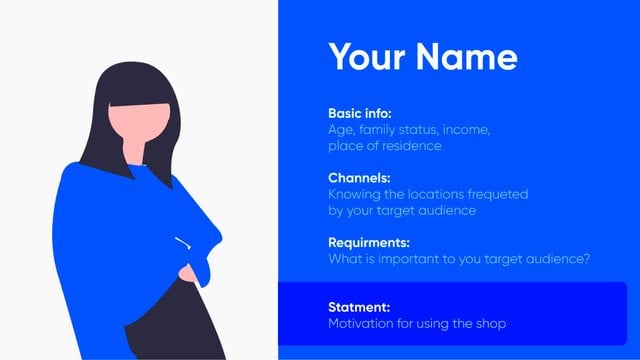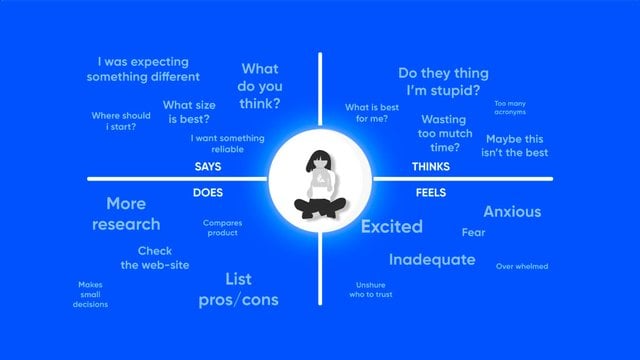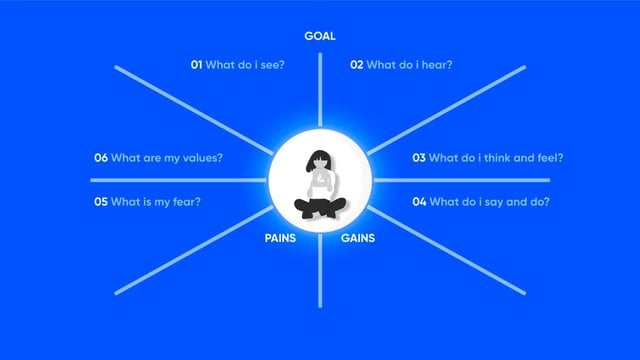The empathy map is kind of a tool, user experience technique which aims to put the developer/manager/project manager in the user’s place. The map allows you to create a portrait of the user, and also helps to solve particular problems of the product.
What is an empathy map?
"If I were in your shoes...", "If I were you ...". For sure, each of us has heard one of these phrases at least once in our life. People usually say them when giving advice and guidance, or when having disputes over something. A person tries “to walk a mile in someone else’s shoes” to understand how he/she would behave in certain circumstances and when having fixed opinions of the world. This is an example of empathy. The term empathy is defined as the understanding of the relationships, feelings or mental states of another person in the form of compassion and joint experience.

What is your target audience?
The empathy map is kind of a tool, user experience technique which aims to put the developer/manager/project manager in the user’s place. The map allows you to create a portrait of the user, and also helps to solve particular problems of the product.
The purpose of an empathy map
Let’s imagine that you are the owner of a restaurant. You are creating a menu for vegetarians. But here's one problem: you love eating meat. So there can be some difficulties with the menu because you do not know quite well how to replace the protein and dietary fibre that a person can get from veal, for example. Then you start researching focusing on customer’s pain points. This is an example of how empathy map works. In fact, it should give the answers to the following questions:
- How does the user feel? What are his/her experiences and goals?
- What can the user's family and friends say if the customer uses our product?
- What would users notice when using our product in their environment?
- What can users say or do when using our service?
- What is the user's pain or fear when using our product?
- What advantages can customer experience have when using our product?

Example of the empathy map
In brief, the map should contain a summary of the answers to all questions that the user faces while using the product. The developer analyzes what emotions the client will feel when receiving a particular service. Does he\she need it? Is it comfortable? Is the service, after all, intuitive or a long and tedious process to explain?
The empathy map is drawn up to solve the following business needs:
- to systematize the knowledge of the target audience at the beginning of development;
- to understand whether the product meets the needs of the target audience;
- to find out from which information channels the user can learn about the service;
- to understand whether a product is needed in the market in general.
How to create a customer empathy map?
To create an empathy map, you must literally put yourself in the user's shoes. You should feel, see and hear what the user does in everyday life. Actually, it is the daily routine that determines the user’s needs and desires. And this is already a good reason to create a product and offer it to the user to solve their pain. Collecting data is important for the design process to create a better product.
There are six blocks of questions that have to be answered during creation.
| Block one. What do I see? | What is the user environment? Where is he\she? What does he/she do? What does he/she pay attention to? Where can the user see our product? |
| The second block. What do I hear? | Every day the user is surrounded by people - relatives, friends, colleagues. What are they talking about? Does he/she listen to the radio in the car? And what kind of programmes does he/she prefer to watch on television? |
| The third block. What do I think and feel? | What are the user's problems and feelings? What does he\she crave and what are his\her most terrible fears? In this block, you can analyze questionnaires from users, go to specialized forums, investigate the market. |
| The fourth block. What do I say and do? | What is the user's routine? What does the person from the target audience do for a living? What products does he\she usually use? Where does he/she rest? Where does he/she go on vacation? In total - all the things that the user can afford or wants to have. |
| Block five. What is my fear? | What is the user afraid of? What are his\her barriers and obstacles that are difficult to overcome? This unit is designed to understand how to make the user's life easier and take upon yourself (i.e., the service) his fears and emotional stress. |
| Block six. What are my values? | What are the user's values? How to bring the product closer to the customer? How to fit the service in the user's life without making him/her feel doubtful or worried? |
So, the empathy map should show four areas: expressions, thoughts, actions, emotions.

Main blocks of the empathy map
Why do you need a personal image?
An empathy map is really necessary if you need to immerse yourself in the user's environment and life. This allows you to develop personal opportunities for the customer, learn about his behaviour, improve the product, find out its weaknesses and strengths. User empathy is needed in order that the user does not have to think about whether he/she needs the service or not. Moreover, when the user learns about it from his/her usual sources, he\she intuitively understands: this product is just for me.
FAQ about an empathy map
Where to start an empathy map?
Conduct the research. Complete each of the four quadrants that are the main ones on the map. If you have a creative team, use the brainstorming method to generate ideas for each block.
Is an empathy map the same as design thinking?
The empathy map is the first step in service design or so-called design thinking. In order to satisfy the user, you need to put yourself in his/her place. If we recall the example mentioned above, the restaurant owner will not be able to make the optimal menu for vegetarians without the research phase of this topic.
How do I know who my user is?
Make a detailed portrait of a person. Imagine who your regular customer is. Draw it to the last detail. Give him a name, a job title and marital status. Move on from the "legend" and answer all the questions in the blocks.
